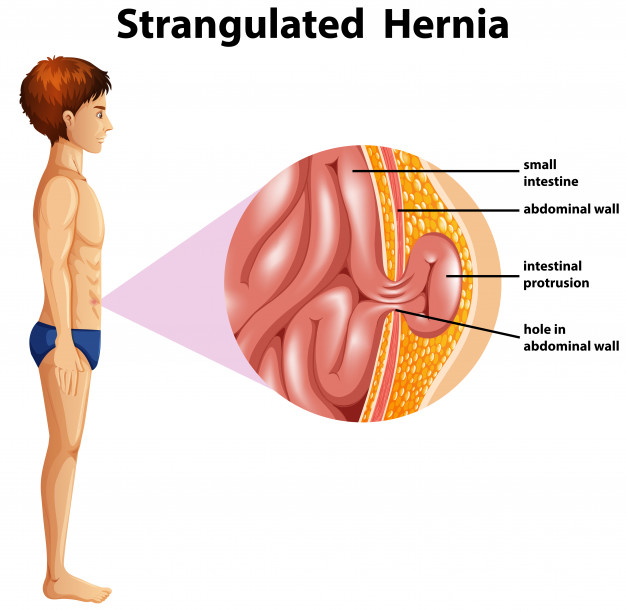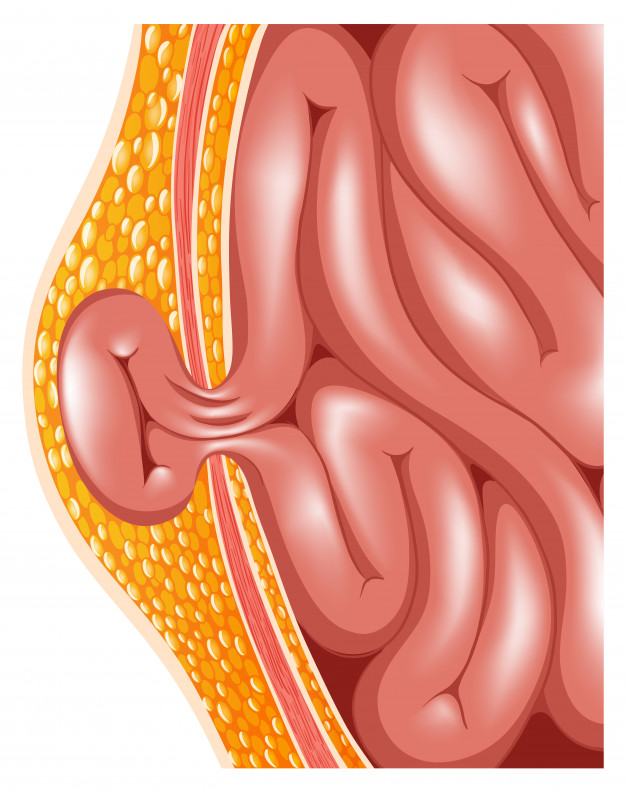A hernia is a common medical condition that occurs when a body partpushes through an opening in the muscle and bulges out of the area in which it is usually contained. In other words, whenever an organ or afatty tissue squeezes in through a weak spot in the surrounding muscle, it leads to hernia. Hernias are a localized bulges and may or may not be painful but are definitely dangerous.
These can be formed anywhere but most commonly occur in the intestine andabdomen region when theintestines break through the weakened area of the abdominal wall.Hernias are also found in the upper thigh region, groin areas, and the belly button. For a few patients, hernias do not have any visible signs or symptoms. They are not an immediate threat to life but pose a massive health risk.
The blood supply is often obstructed to the herniated area. If the herniated arearemains cut off from oxygen and blood supply for an extended duration of time, it can turn fatal for the patient. A hernia does not go away on its own and requires treatment. In a few cases, immediate surgery becomes critical to prevent complications.
There are many different types of hernias. A few of them are commonly found in women while the others are prevalent in men.It is beneficial to understand the types of hernias and be aware of any symptoms to know the right time to see a doctor.We are discussing the seven different types of hernias in this write-up, please read till the end for a clear understanding and differentiationbetween them all:

- Groin Hernia: Also called the Inguinal Hernia, as much as 75% abdominal wall hernias are groin hernias. This type of hernia affects the groin area and makes the thigh skin join the torso. A groin hernia is roughly 25% more probable to occur in men.Further, there are two types of groin hernia – direct and indirect.While the indirect groin hernia can occur at any age, most middle age and elderly men who suffer from hernia, have the direct groin hernia.Hernia surgeons operate the groin hernia to put the bulge back into its place.
- Femoral Hernia: The passage through which the femoral artery, vein, and nerve leave the adnominal area to enter the upper thigh is called the femoral canal. If the abdominal contents enter the femoral canal, the femoral canal enlarges and leads to hernia. This hernia causes a lump in the groin or the inner thigh region and severe groin discomfort. In some critical cases, patients may even complain of stomach ache and vomiting.This type of hernia is more common in women, especially those who are pregnant or obese. The femoral hernia is reported in only 5% of patients suffering from a hernia but a surgical procedure is necessary else it may lead to critical complications.
- Umbilical Hernia: About 10 to 30 percent of all reported cases of hernia are umbilical hernia cases. This is a fairly common condition for new born babies but there have also been a few cases of umbilical hernia in obese women and women who have had many children. The umbilical hernia, caused by an opening in the abdominal wall, can be recognized by the protrusion of the belly button in new born babies.If the opening is smaller than half an inch, it closes on its own by the time the new born turns two years old. However, if the opening is larger, a surgery becomes unavoidable and the child can be operated when he/she is between two to four years of age. Even after the opening is closed whether naturally or by surgery, the area remains weaker and prone to problems.
- InscisionalHernia: This type of hernia is caused when an abdominal surgery wound does not heal properlyand creates a weak area. The inscisional hernias occur in 2 to 10% of abdominal surgeries and may even happen months or years after the abdominal surgery.A few patients undergoing abdominal surgery are more prone to inscisional hernias than others and hence you must speak to your surgeon before the surgery. These can be treated by open surgery or minimally invasive laparoscopic surgeries.
- Spigelian hernia: This rare type of hernia, also called the lateral ventral hernia, is the hernia that occurs in the spigelian fascia i.e. the tissue layer that separates the two groups of abdominal muscles. It does not develop below the layers of fat but occurs along the rectus abdominal muscle and happens a few inches in the side of the middle of the abdomen.This is a rare but dangerous and life-threatening form of hernia as it blocks a portion of the bowel and cuts off the blood supply to body parts and tissues.
- ObsturatorHernia: This type of pelvic herniais rare but has the highest mortality rate amongst the others. More prevalent in older womenwho are very thin, this hernia protrudes from the pelvic cavity through the opening in the pelvic bone. These hernias generally do not have a bulge and are thus difficult to diagnose. These restrict the bowel movements and cause nausea, vomiting, stomach ache, abdominal bloating, and even constipation.
- Epigastric Hernia: The epigastric hernia is often painless and occurs in the upper part of the abdominal wall area that is called the epigastrium. This area is between the navel and the lower part of the rib cage. These hernias may be present at the time of birth and vary largely in size. A patient can have more than one epigastric hernia at once.
This hernia is usually made of fatty tissues, does not contain intestinal matter, and is formed in the relatively weaker area of the abdominal wall. The smaller epigastric hernias do not cause any harm but may be visible when the patient is lying down.
At Ananya Gastroenterology, Dr. Ananda Kumar is a highly qualified laparoscopic hernia surgeon and is experienced in treating even the most critical cases of recurring hernias. Schedule your appointment to get instant relief from pain and fix the hernia before it becomes a serious threat to life.

